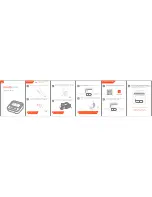
2
1. Important Facts about Blood Pressure and Self-
Measurement
•
Blood pressure
is the pressure of the blood flowing in the
arteries generated by the pumping of the heart. Two values, the
systolic
(upper) value and the
diastolic
(lower) value, are
always measured.
•
Permanently high blood pressure values can damage your
health and must be treated by your doctor!
•
Always discuss your values with your doctor and tell him/her if
you have noticed anything unusual or feel unsure.
Never rely
on single blood pressure readings.
•
There are many causes of excessively
high blood pressure
values
. Your doctor will explain them in more detail and offer
treatment where appropriate. Besides medication, relaxation
techniques, weight loss and exercise can also lower your blood
pressure.
•
Under no circumstances should you alter the dosages of
drugs or initiate a treatment without consulting your doctor.
•
Depending on physical exertion and condition, blood pressure
is subject to wide fluctuations as the day progresses.
You
should therefore take your measurements in the same
quiet conditions and when you feel relaxed!
Take at least
two measurements per day, one in the morning and one in the
evening.
•
It is quite normal for two measurements taken in quick succes-
sion to produce significantly
different results
.
•
Deviations
between measurements taken by your doctor or in
the pharmacy and those taken at home are quite normal, as
these situations are completely different.
•
Several measurements
provide a much clearer picture than
just one single measurement.
•
Leave a small break
of at least 15 seconds between two
measurements.
•
If you are
pregnant
, you should monitor your blood pressure
regularly as it can change drastically during this time.
How do I evaluate my blood pressure?
The higher value is the one that determines the evaluation.
Example: a blood pressure value of
140/80
mmHg or a value of
130/90
mmHg indicates «blood pressure too high».
2. Using the Device for the First Time
Using the correct cuff
When choosing the correct size cuff the arm circumference should
be measured at the centre of the upper arm. 25.4 - 40.6 cm (10 -
16 inches) should be the correct size for the majority of people.
Only use Microlife cuffs.
Contact your local Microlife Service if the enclosed cuff
2
does
not fit.
3. Taking a Blood Pressure Measurement
Checklist for taking a reliable measurement
1. Avoid activity, eating or smoking immediately before the
measurement.
2. Sit down on a back-supported chair and relax for 5 minutes.
Keep the feet flat on the floor and do not cross your legs.
3. Always measure on the same arm (normally left).
4. Remove close-fitting garments from the upper arm. To avoid
constriction, shirt sleeves should not be rolled up - they do not
interfere with the cuff if they are laid flat.
5. Always ensure that the correct cuff size is used (marking on the
cuff).
•
Fit the cuff closely, but not too tight.
Table for classifying home blood pressure values in adults in
accordance with the international Guidelines (ESH, AHA, JSH).
Data in mmHg.
Range
Systolic Diastolic Recommendation
1. blood pressure
normal
< 120
< 74
Self-check
2. blood pressure
optimum
120 - 129 74 - 79
Self-check
3. blood pressure
elevated
130 - 134 80 - 84
Self-check
4. blood pressure too
high
135 - 159 85 - 99
Seek medical
advice
5. blood pressure
dangerously high
≥
160
≥
100
Urgently seek
medical advice!
Summary of Contents for BP AG1-40
Page 11: ...9 BP AG1 40 PL...





























